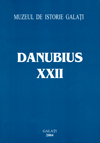Justiţie şi expropriere în România puterii populare
Justice and dispossession in Romania, during the popular government
Author(s): Cezar AvramSubject(s): History
Published by: Muzeul de Istorie „Paul Păltănea” Galaţi
Summary/Abstract: The collectivisation of the Romanian agriculture, after the model of the Stalinist Kolhoz, was one of the ample activities meant to transform the economy of the country and the social, political and moral spectrum of the people, to allow the perpetuation of the power of the unique party and of the Communist government. The abolition of the individual property of the peasants, “in order not to block the development of the Socialist agriculture”, subsequent to the nationalisation of industry, was meant to exclude, “for the present and for the future”, the resistance hotbeds against the Communist totalitarian state. In the vision of the Communist party, the triumph of Socialism in Romania was incompatible with the preservation of the private property of the land. Along with the destruction of the private land property, the land owner also disappeared and, therefore, “a virtual and morbid” ally of the outside enemy - “the imperialism” – was also annihilated.
Journal: Danubius
- Issue Year: XXII/2004
- Issue No: 1
- Page Range: 157-167
- Page Count: 11
- Language: Romanian

